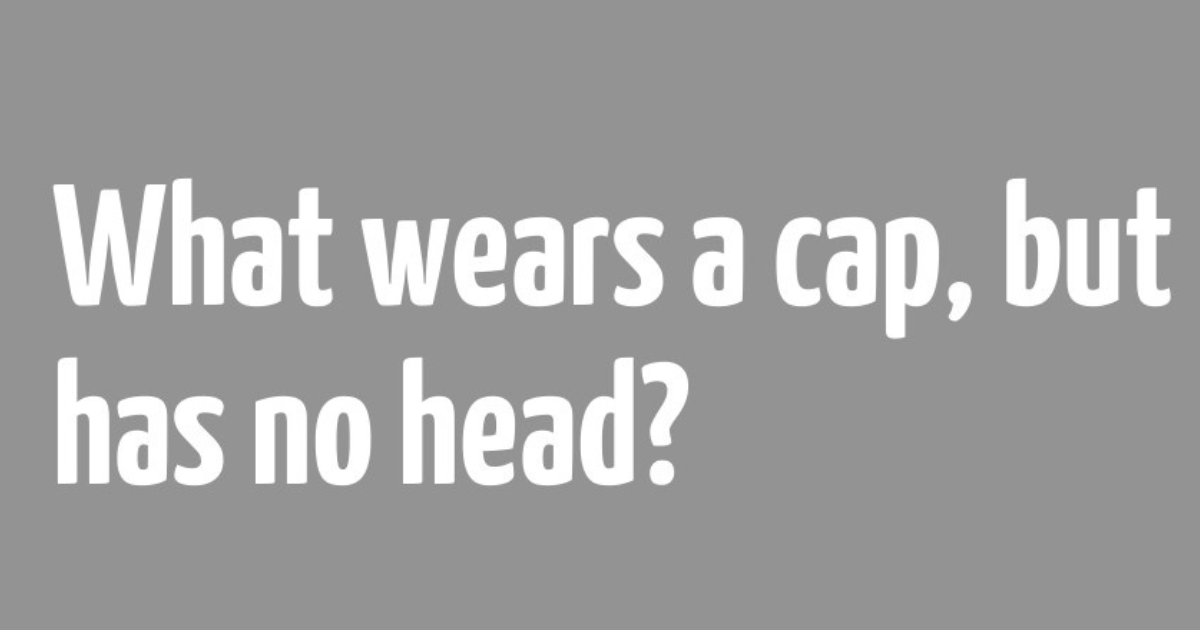Riddles have been part of human culture for centuries. They challenge our thinking, offer amusement, and teach us to view things from different perspectives. One famous riddle that has left people puzzled is: “What has a neck but no head?” At first glance, it sounds like an impossible question. How can something have a neck but no head? But like most riddles, the answer lies in thinking outside the box.
The Simple Answer
The answer to the riddle “What has a neck but no head?” is a bottle. Surprising, right? Bottles have a part referred to as the “neck,” but they don’t have a head. It’s a simple and clever way of playing with words, using a familiar object to present a mind-bending question.
But why exactly do we refer to the top part of a bottle as its “neck”? And are there other objects or things with necks that don’t have heads? Let’s dive deeper into this fascinating concept.
Why Is It Called A “Neck”?
The use of the word “neck” in relation to a bottle isn’t just a random choice. Much like a human neck connects the head to the body, the neck of a bottle connects its mouth (the opening) to the body (the larger, main part of the bottle).
The neck of the bottle is typically narrow, making it easier to pour liquids without spilling. Just like a human neck that provides flexibility and mobility to our heads, the neck of a bottle offers convenience in terms of handling and pouring.
This naming convention isn’t limited to just bottles. Many items are described based on their resemblance to human body parts. For example, we often refer to the “foot” of a bed or the “arm” of a chair. These metaphors help us relate to objects based on what we already know.
The Function Of A Bottle’s Neck
The design of a bottle’s neck isn’t purely decorative. There are practical reasons behind this shape. Here are a few key functions:
- Control Over Pouring: The narrow neck helps control the flow of liquids, ensuring they pour smoothly without splashing. This is especially important for items like wine or olive oil.
- Easy Gripping: The neck offers a place to hold the bottle securely, making it easier to handle, especially when the bottle is full and heavy.
- Better Sealing: Bottles with necks are often sealed with caps or corks, and the narrow neck ensures a tighter fit, keeping the contents fresh and preventing spills.
Other Items With Necks And No Heads
While a bottle is the most common answer to the riddle, other objects also have necks without heads. Let’s explore a few:
- Vases: Like bottles, vases have a narrow neck leading to the opening. This design helps support flowers and allows for easier handling, much like the neck of a bottle.
- Jars: Though less pronounced than a bottle’s neck, jars often have a slightly narrower top portion to hold lids or caps in place securely. The neck helps with sealing and preserving the contents.
- Musical Instruments: String instruments like guitars and violins have necks where the strings are held, even though they don’t have heads in the traditional sense. The neck of these instruments plays a crucial role in tuning and playing music.
- Lamps: Many table lamps have neck-like structures between the base and the light source. These necks allow for adjustable height and flexibility in positioning the light.
Why Do Riddles Use Metaphors?
Riddles like “What has a neck but no head?” use metaphors to engage our minds creatively. They encourage us to think about everyday objects in new and unexpected ways. By using familiar terms in unfamiliar contexts, riddles stretch our imagination and problem-solving skills.
This use of metaphor is not just limited to riddles. We use metaphorical language all the time in everyday speech without even realizing it. For instance, when we say someone is “the heart” of the organization, we don’t mean they’re literally a heart, but that they play a vital and central role, just like the heart does in the human body.
Riddles And Brain Benefits
Besides being fun, riddles provide mental benefits. Here’s how they help:
- Improved Critical Thinking: Solving riddles involves thinking critically and logically. You have to look beyond the obvious and consider various possibilities.
- Boosting Creativity: Riddles encourage you to think creatively by presenting questions in unconventional ways. This helps in developing out-of-the-box thinking skills.
- Enhancing Vocabulary: Riddles often use clever wordplay, which can introduce you to new words or give you a deeper understanding of familiar ones.
- Strengthening Memory: Puzzles like riddles require you to recall information, which helps improve memory and cognitive function over time.
The Appeal of Simple Riddles
The charm of riddles like “What has a neck but no head?” lies in their simplicity. They use ordinary objects and ask us to think about them in unusual ways. What makes this riddle particularly appealing is how it plays with our expectations. The idea of something having a neck but no head sounds nonsensical at first, but when you realize the answer is something as familiar as a bottle, it brings a sense of satisfaction and amusement.
The simplicity of such riddles also makes them accessible to people of all ages. Children can easily understand and solve them, while adults enjoy the mental challenge and humor. Riddles act as a bridge between generations, offering a shared experience of fun and learning.
Conclusion
Riddles like “What has a neck but no head?” are not just fun word puzzles—they are a way to engage our brains and see the world differently. The answer, a bottle, reminds us how language and objects often overlap in ways we don’t always think about. Whether you’re a fan of riddles or just someone who enjoys learning new things, taking time to solve puzzles like this one can be both entertaining and intellectually rewarding.

